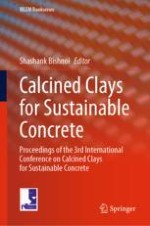2020 | OriginalPaper | Buchkapitel
Influence of Calcined Clay-Limestone Ratio on Properties of Concrete with Limestone Calcined Clay Cement (LC3)
verfasst von : Yuvaraj Dhandapani, Manu Santhanam
Erschienen in: Calcined Clays for Sustainable Concrete
Verlag: Springer Singapore
Aktivieren Sie unsere intelligente Suche, um passende Fachinhalte oder Patente zu finden.
Wählen Sie Textabschnitte aus um mit Künstlicher Intelligenz passenden Patente zu finden. powered by
Markieren Sie Textabschnitte, um KI-gestützt weitere passende Inhalte zu finden. powered by
